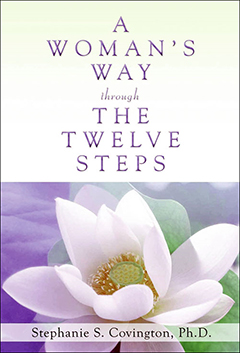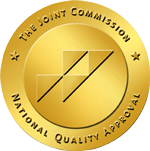
"As your Twelve Step journey continues, your sense of self, your picture of who you are, is likely to change."

Other titles you may like.

A Woman's Way through the
Twelve Steps Workbook
Visit Recovery Road to view and
listen to all the episodes.
Episode 160 -- October 25, 2021
How to Reconnect to Your Self in Recovery
Early in recovery, many of us have no idea who we are. In letting go of our addiction, we have lost part of our identity—the part that made all our decisions and framed all our relationships. The force that once dictated how we did everything no longer has control. Now that we're no longer defined by our worst moments and least healthy impulses, it's time to figure out what we value, what we can trust, and who we want to become.
In her book A Woman's Way through the Twelve Steps, Dr. Stephanie Covington explores the Twelve Step program from a woman's perspective, empowering readers to take ownership of their own recovery process as well as their growth. Dr. Covington's invitation to self-connection in the following excerpt applies to all of us, regardless of gender. Now that we are reclaiming ourselves from addiction, who are we, what are we feeling, and what do we want?
This excerpt has been edited for brevity.
Beginning recovery is about discovering the self. When we come into recovery we expect to focus on alcohol or drugs or food or sex or money, or some combination of these that was our addictive behavior. Recovery is about addiction, but it is about much more: it is about finding out who you are and coming to a deeper understanding of your self.
The self is what is unique about our identity and character. It helps us organize our experience and make sense of our reality. The self gives purpose and direction to our choices and behavior. It is the part of us that says I feel, I like, I want, I know.
When we were addicted, our connection to our self—our experience, our feelings, and our deep inner knowing—was cut off. We were numbed, confused, unclear, and disconnected. We had lost our capacity to know what was true for our self, and without that sense of self, we lost our ability to relate with others.
We first begin to discover ourselves in recovery by acknowledging our addiction. This is a paradox of recovery: we begin to heal ourselves by first identifying with the addiction that has damaged the self. When we go to meetings, we introduce ourselves with, "Hello, my name is _____. I am an alcoholic." This first identification with our addiction helps us begin the process of looking at self. Later, as our recovery continues, we find that this identification is only one aspect of self.
Identifying honestly with our addiction may be our first opportunity to think about ourselves, to ask the question, Who am I? This question leads us to a deeper understanding of the self—to what is changeless and unique about each of us.
To start to discover your unique identity you might begin to make a list of words that describe who you are. Leave out words like mother and wife, or job titles. These words describe some of the roles you play, but not who you are.
You might find you struggle with this exercise and don't have anything to list. It may be hard to come up with words to describe who you are rather than what you do. Try working with your sponsor or a friend. Ask trusted people around you to suggest words to help fill out your picture of yourself. You will find this process urges you to go deeper inward to ask yourself, Who am I? What words describe what is unique about me?
As your Twelve Step journey continues, your sense of self, your picture of who you are, is likely to change. Keep working on your list over the course of your recovery and see how your picture of yourself grows and changes. You will probably find you move from your first self-identification with your addiction to a deeper, more complex sense of who you are.
This more complex sense of self includes the feelings unique to each of us. So, our second question is, What do I feel?
Recognizing our feelings can be a frightening process. For years we avoided feelings through our addiction. We numbed ourselves with alcohol or drugs or food or a whole variety of other addictive behaviors. We disconnected our thoughts from our feelings so that we would not know what we were feeling; in fact we didn't really feel at all. It was as if we were in a perpetual fog. We were disconnected from our feelings, with little sense of an inner life.
When we stopped our addictive behaviors, we were often surprised by the strength of our feelings. Many women in early recovery talk about being overwhelmed by feelings.
At first you may experience only a vague sensation. You may not even have words to describe it. Often it is helpful to look at a list of feeling words. As you begin to sort out your feelings and put language to vague sensations, you come closer to finding out who you really are.
Although what we feel isn't who we are, recognizing our feelings is part of the journey towards discovering our self. As we move deeper into our self, we find that we are able to clarify what we feel. Exploring these feelings leads to an undiscovered inner reality that eventually reveals more about the self.Once we begin to recognize and identify our feelings, we then begin to ask ourselves a third question: What do I like, or what do I want? By examining our values, we begin to match our inner feelings with our outer behaviors.
When we were addicted, we often found ourselves acting against our own value systems. Many of us said, "I won't be drunk at my son's wedding," but we were; or "I'd never consider having an affair," but we did; or "I would certainly never binge on chocolate cake in a public place," yet we ate piece after piece. Each time we did something contrary to our values, we suffered a loss of self and a lowered sense of self-esteem.
When we begin to recognize our feelings as a signal that we don't like something we're doing, we reconnect our inner reality with our values. This is a process of expanding our feeling self. Being able to feel on a much broader spectrum with a lot more subtlety empowers us to grow and become whole. Understanding that we have an inner self, and an outer self allows us to expand our sense of self. Then we can connect the inner and the outer self, matching our feelings, our values, and our needs to our choices and our behaviors. But we have to be in touch with our inner reality, to first know what we are feeling. What do I feel? What do I need? What do I want?
About the Author:
Stephanie S. Covington, PhD, LCSW, is a nationally recognized clinician, author, organizational consultant, and lecturer. A pioneer in the field of women's issues and addiction and recovery for many years, she has developed an innovative, gender-responsive approach to address the treatment needs of women and girls that results in effective services in public, private, and institutional settings. Her clients include treatment and correctional settings.
© 1994 by Stephanie S. Covington, PhD.
All rights reserved



